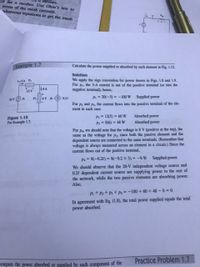
Introductory Circuit Analysis (13th Edition)
13th Edition
ISBN: 9780133923605
Author: Robert L. Boylestad
Publisher: PEARSON
expand_more
expand_more
format_list_bulleted
Concept explainers
Question

Transcribed Image Text:of the n meshes. Use Ohm's law to
meshes,
a terms of the mesh currents.
ultaneous equations to get the mesh
www
Example 1.7
Calculate the power supplied or absorbed by each element in Fig. 1.15.
Solution:
We apply the sign convention for power shown in Figs. 1.8 and 1.9.
For Pi, the 5-A current is out of the positive terminal (or into the
negative terminal); hence,
1-5A P2
12 V
8V P
P1 = 20(-5) =-100 W
Supplied power
20 V
P3
0.2)
For p2 and p3, the current flows into the positive terminal of the ele-
ment in each case.
P2 = 12(5) = 60 W
Absorbed power
Figure 1.15
For Example 1.7.
P3 = 8(6) = 48 W
Absorbed power
For P4, we should note that the voltage is 8 V (positive at the top), the
same as the voltage for p3, since both the passive element and the
dependent source are connected to the same terminals. (Remember that
voltage is always measured across an element in a circuit.) Since the
current flows out of the positive terminal,
P4 = 8(-0.21) = 8(-0.2 x 5)= -8 W
Supplied power
We should observe that the 20-V independent voltage source and
0.21 dependent current source are supplying power to the rest of
the network, while the two passive elements are absorbing power.
Also,
Pi + P2 + P3 + p4 = -100 + 60 + 48-8 0
In agreement with Eq. (1.8), the total power supplied equals the total
power absorbed.
Practice Problem 1.7
Compute the power absorbed or supplied by each component of the
Expert Solution
This question has been solved!
Explore an expertly crafted, step-by-step solution for a thorough understanding of key concepts.
This is a popular solution
Trending nowThis is a popular solution!
Step by stepSolved in 2 steps with 1 images

Knowledge Booster
Learn more about
Need a deep-dive on the concept behind this application? Look no further. Learn more about this topic, electrical-engineering and related others by exploring similar questions and additional content below.Similar questions
- When a car has a dead battery, it can often be started by connectingthe battery from another car across its terminals. The positive terminalsare connected together as are the negative terminals. The connection isillustrated in P1.12. Assume the current i in P1.12 is measuredand found to be 40 A.1. a) Which car has the dead battery?2. b) If this connection is maintained for 1.5 min, how much energy istransferred to the dead battery?arrow_forwardP1.36 Consider the circuit shown in Figure P1.36. a. Which elements are in series? b. What is the relationship between ia and i? c. Given that i, = 3 A and i. = 1 A, determine the values of i, and ig. A Figure P1.36arrow_forwardPlease answer in typing formatarrow_forward
arrow_back_ios
arrow_forward_ios
Recommended textbooks for you
 Introductory Circuit Analysis (13th Edition)Electrical EngineeringISBN:9780133923605Author:Robert L. BoylestadPublisher:PEARSON
Introductory Circuit Analysis (13th Edition)Electrical EngineeringISBN:9780133923605Author:Robert L. BoylestadPublisher:PEARSON Delmar's Standard Textbook Of ElectricityElectrical EngineeringISBN:9781337900348Author:Stephen L. HermanPublisher:Cengage Learning
Delmar's Standard Textbook Of ElectricityElectrical EngineeringISBN:9781337900348Author:Stephen L. HermanPublisher:Cengage Learning Programmable Logic ControllersElectrical EngineeringISBN:9780073373843Author:Frank D. PetruzellaPublisher:McGraw-Hill Education
Programmable Logic ControllersElectrical EngineeringISBN:9780073373843Author:Frank D. PetruzellaPublisher:McGraw-Hill Education Fundamentals of Electric CircuitsElectrical EngineeringISBN:9780078028229Author:Charles K Alexander, Matthew SadikuPublisher:McGraw-Hill Education
Fundamentals of Electric CircuitsElectrical EngineeringISBN:9780078028229Author:Charles K Alexander, Matthew SadikuPublisher:McGraw-Hill Education Electric Circuits. (11th Edition)Electrical EngineeringISBN:9780134746968Author:James W. Nilsson, Susan RiedelPublisher:PEARSON
Electric Circuits. (11th Edition)Electrical EngineeringISBN:9780134746968Author:James W. Nilsson, Susan RiedelPublisher:PEARSON Engineering ElectromagneticsElectrical EngineeringISBN:9780078028151Author:Hayt, William H. (william Hart), Jr, BUCK, John A.Publisher:Mcgraw-hill Education,
Engineering ElectromagneticsElectrical EngineeringISBN:9780078028151Author:Hayt, William H. (william Hart), Jr, BUCK, John A.Publisher:Mcgraw-hill Education,

Introductory Circuit Analysis (13th Edition)
Electrical Engineering
ISBN:9780133923605
Author:Robert L. Boylestad
Publisher:PEARSON

Delmar's Standard Textbook Of Electricity
Electrical Engineering
ISBN:9781337900348
Author:Stephen L. Herman
Publisher:Cengage Learning

Programmable Logic Controllers
Electrical Engineering
ISBN:9780073373843
Author:Frank D. Petruzella
Publisher:McGraw-Hill Education

Fundamentals of Electric Circuits
Electrical Engineering
ISBN:9780078028229
Author:Charles K Alexander, Matthew Sadiku
Publisher:McGraw-Hill Education

Electric Circuits. (11th Edition)
Electrical Engineering
ISBN:9780134746968
Author:James W. Nilsson, Susan Riedel
Publisher:PEARSON

Engineering Electromagnetics
Electrical Engineering
ISBN:9780078028151
Author:Hayt, William H. (william Hart), Jr, BUCK, John A.
Publisher:Mcgraw-hill Education,